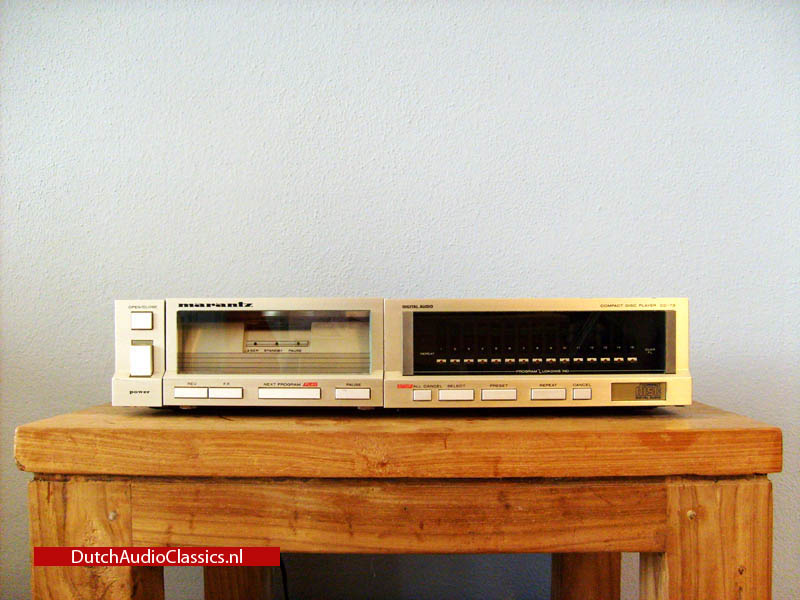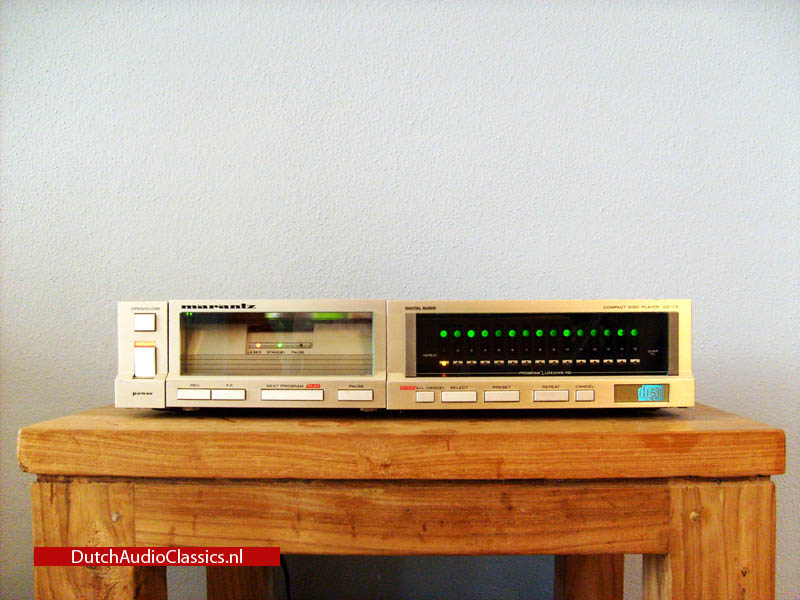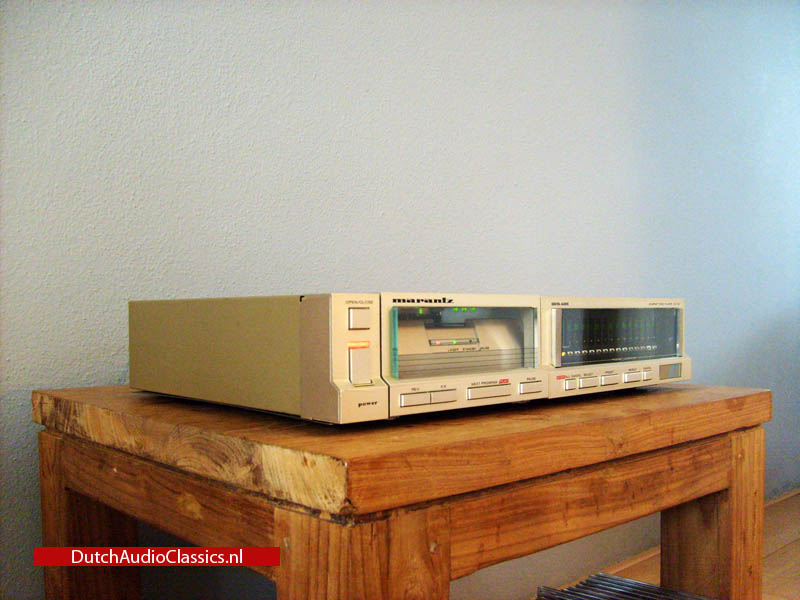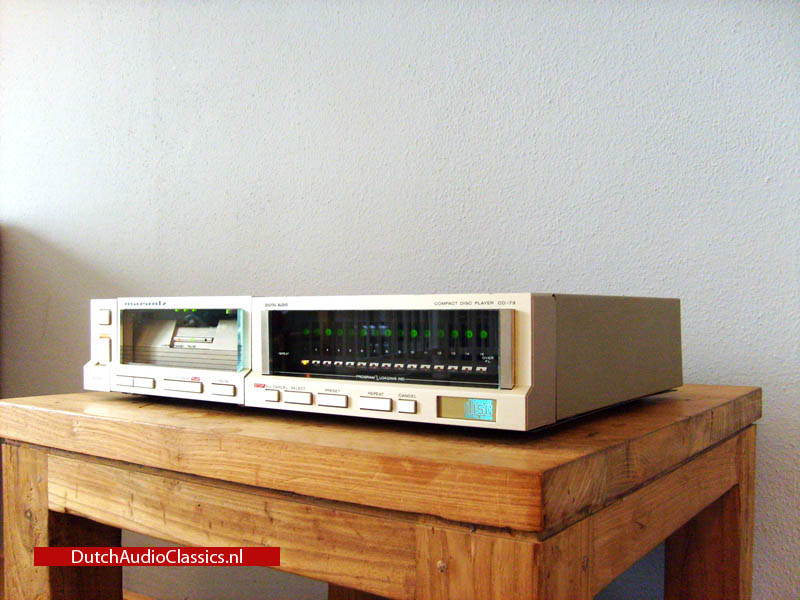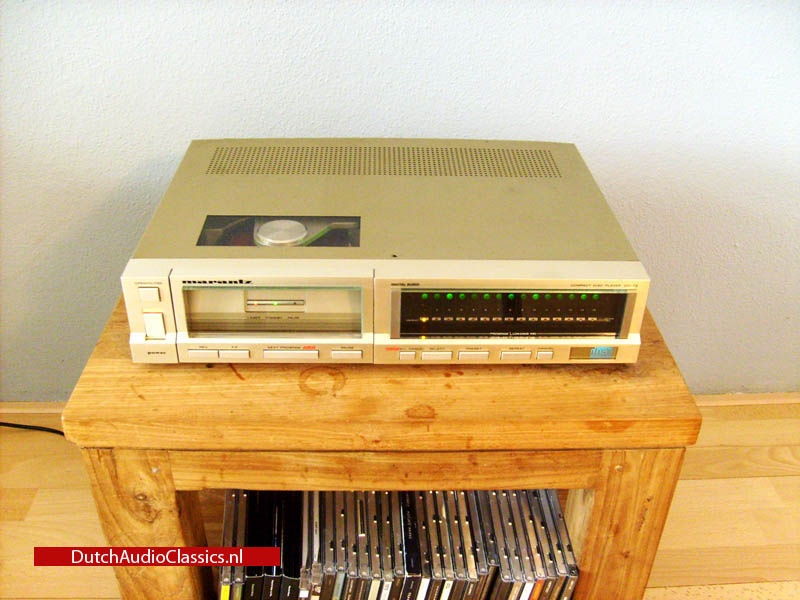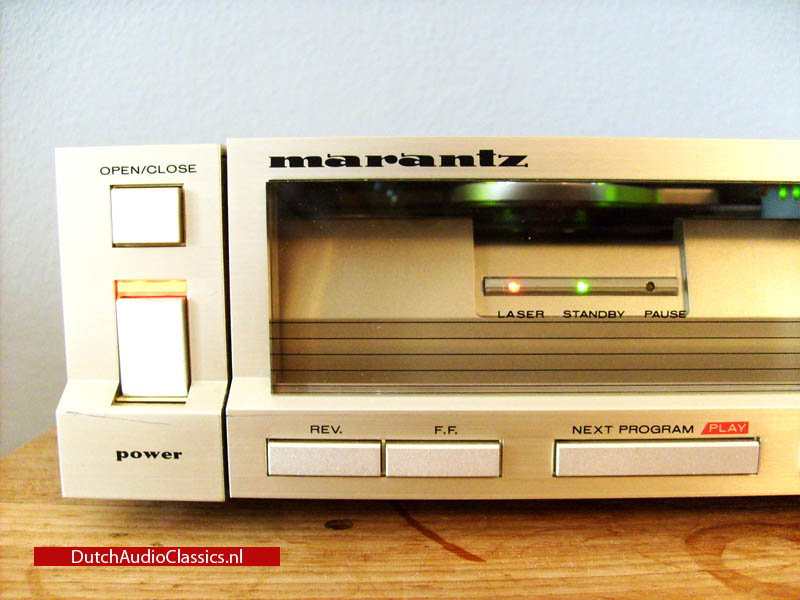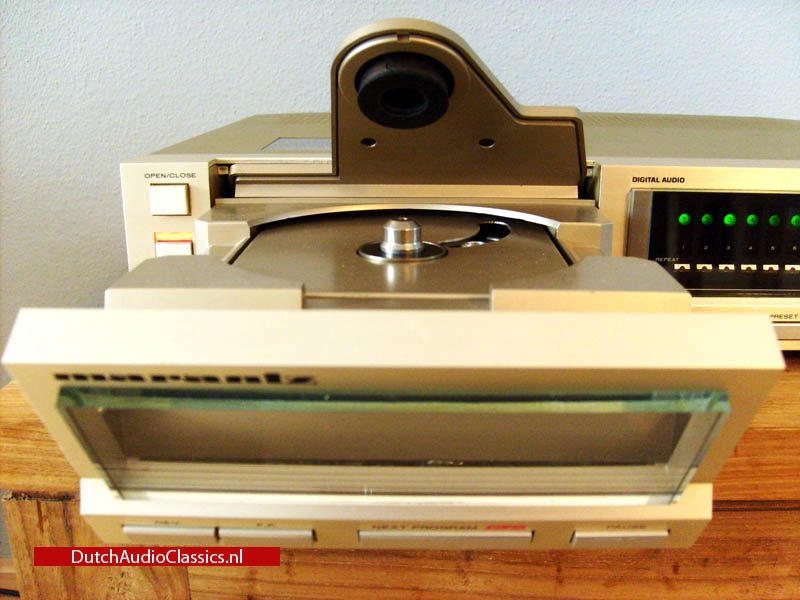The styling of the gold-colored Marantz CD73 Compact Disc player matches that of other Marantz audio components. Its low -profile design (only 31/4 inches in height) makes it one of the more compact CD players on the market. For play, a disc is placed on a horizontal "turntable" that emerges smoothly from the f runt panel of the Marantz CD73 when the OPEN/CLOSE button (above the power button at the left side of the panel) is pressed. A second touch of the OPEN/CLOSE button causes an overhead retaining arm to clamp down over the record and spindle as the drawer returns to its normal position within the player. A large window occupying most of the right half of the panel contains a horizontal row of fifteen green LED's, corresponding to the programming capacity of the player's memory system, and a similar row of small amber lights extends across the bottom of the window area.
Marantz CD73Most advanced cdplayer
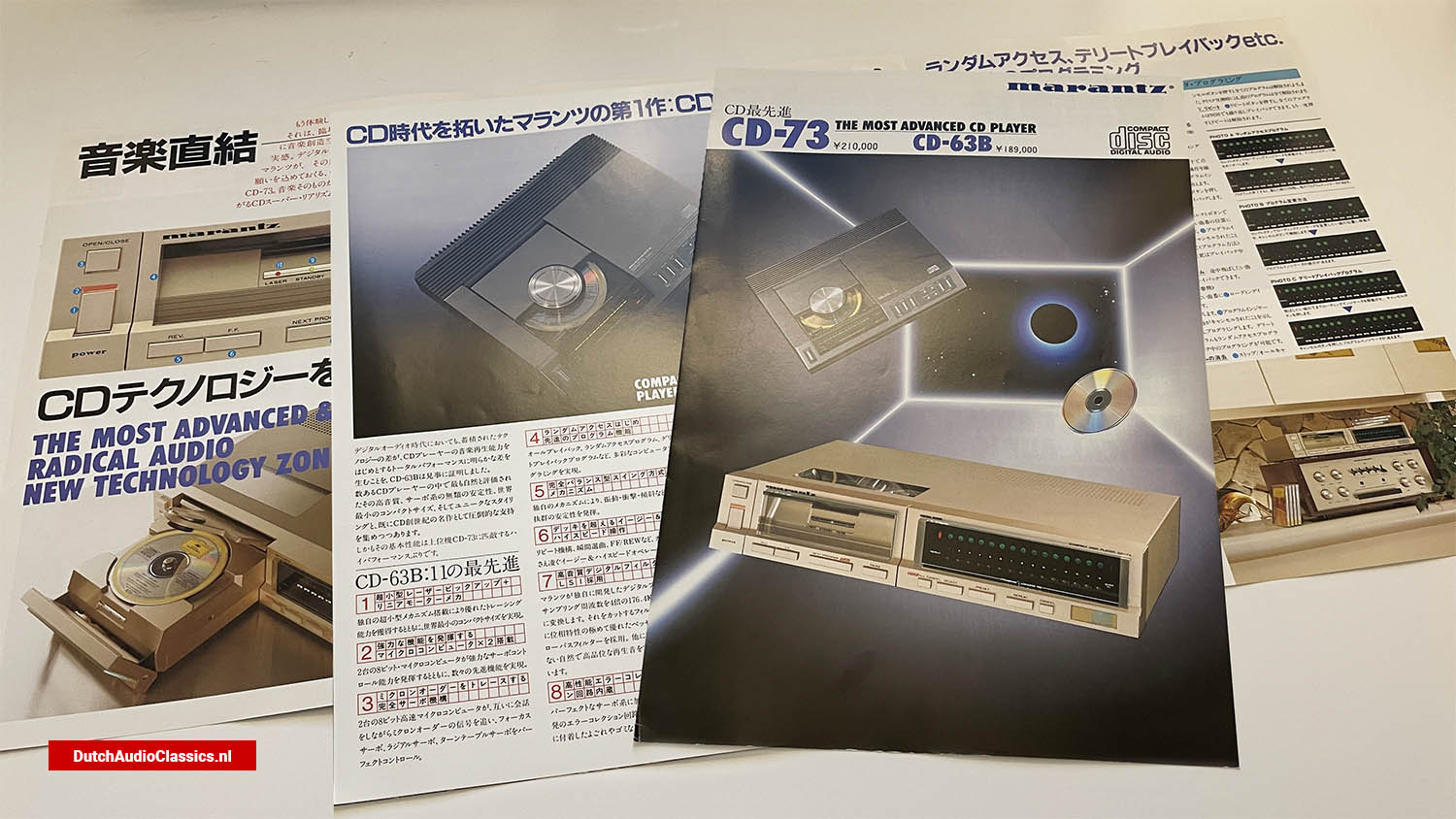
From the 1983 brochure:
Ultra-compact laser pick-up +Linear motor mechanism
Equipped with an ultra-compact mechanism that precisely drives a unique ultra-compact laser pick-up with a linear motor. It is the basis of the Marantz CD-73's superior tracing capability, which perfectly follows and accurately detects microscopic signals.
Drawer system - Easy loading mechanism
The linear skating mechanism, which has an established reputation in Marantz cassette decks, is incorporated in the Marantz CD-73. The Marantz CD-73 brings together the fruits of this success and dramatically improves the operability of the CD player. The Marantz CD-73 features a laser unit that can be automatically drawn out and retracted with the touch of a switch, and together with the unique disc clamping system, ensures reliable, easy loading.
Powerful functions - Microcomputer X 2 on-board
Two microcomputers are installed to exploit the full potential of CD digital audio. They demonstrate their advanced capabilities in servo, programme and control systems in every direction, realising a number of functions that have only become possible in the digital audio age.
Makes a difference to sound quality - Digital filter 1-Lsi
Marantz proved with its first CD player, the Marantz CD-63B, that even in the digital audio age, there are clear differences in sound quality between models. The unavoidable effect on the audible bandwidth of a normal multi-stage analogue low-pass filter.
Microcomputer-based - Perfect servo
Two 8-bit high-speed microcomputers talk to each other and follow the micron-order signal to provide powerful control of focus servo, radial servo and turntable servo. The system controls the focus servo, radial servo and turntable servo.
Random access and more - Advanced programming functions
The microcomputer allows free programming of song selection. Advanced features unique to CD digital audio include a random access programme that allows playback of up to 15 tracks in any order, and a delete playback programme that automatically skips any number of tracks in the middle of a track.
Fully balanced - Swing-type mechanism
A unique, fully balanced swing-type mechanism is used for the pickup support system. The pickup support system uses a unique, fully balanced swing-type mechanism. It is highly resistant to vibration and tilting and provides outstanding stability. The pickups are highly responsive even during random access operation, enabling speedy head start.
Easier than a deck - High-speed operation
The repeat mechanism allows you to play back a programme as many times as you like. Instantly skip to the next song in the middle of a song, including the NEXT PROGRAM button, FF/REW button for speedily moving from the current playback point to the next or previous one, etc. The FF/REW button allows you to quickly move from the current playback position to the next or previous position. The easy and high-speed operation surpasses not only current record players, but also cassette decks.
Playback status at a glance - Super-large display
The large layout of the loading indicator shows the programme indicator for the selected programme number, the song number during playback and the song number at the time of song selection. The playback status can be checked at a glance.
circular error correction intervals
In addition to a perfect servo system, a specially developed error correction circuit is employed. The disc has a high error correction capability that ensures trouble-free playback even if some dirt or debris adheres to the disc.
Disc clamping system
The ultra-precision machined spindle and unique magnetic disc clamping system have been newly developed. Moreover, this disc clamper opens and closes automatically as the laser unit is withdrawn/stowed. The disc clamper opens and closes automatically as the laser unit is withdrawn/stowed, so you only need to pop the disc in place to hold it perfectly in the correct position.
Discs that float
Discs in playback are illuminated green and can be viewed through the disc room window. Energy savings are achieved through the use of a low-power semiconductor laser. The pickup containing this semiconductor laser is also exceptionally ultra-compact thanks to Marantz's unique optical system configuration.
A disc can be played from its beginning by pressing the NEXT PROGRAM/PLAY button below the loading door. As soon as the disc begins to rotate, the player's circuits determine the number of selections ("tracks") and light up a corresponding number of the green LED's in the display window. In operation, an amber light always indicates the particular track being played and the green lights show how many remain to be played. Pressing the NEXT PROGRAM/PLAY button at any time advances the player to the beginning of the next programmed selection (or simply to the next track if there is no programmed sequence).

like most CD players, the Marantz unit has a PAUSE button that instantly interrupts play, which resumes at the same point the next time the button is pressed. Buttons marked REv. and F.F. slew the laser pickup back or forward while they are held in. In this mode, however, there is no audio output and no indication of pickup position other than the amber light designating the track being scanned.
The programming controls of the Marantz CD73 are located under the display window. They can be set to play or to omit any of the tracks on a disc, to a maximum of fifteen. The amber light corresponding to any track can be lit by pressing the SELECT button from one to fifteen times, and pressing PRESET enters that selection into memory (its green track -number light remains on to show that it has been programmed). Alternatively, the CANCEL button can be used to delete a selection from the program (extinguishing its green LED).
After the player has been programmed, pressing NEXT PROGRAM/PLAY starts the playback sequence. The disc turns and the amber lights advance sequentially to the first programmed track, which is then played. The playing sequence follows the programmed pattern until the last selection has been completed, after which the unit shuts off. At any time, pressing STOP/ALL CANCEL cancels the programmed sequence and stops the player. Pressing REPEAT causes all programmed tracks to be repeated indefinitely until the button is pressed again.
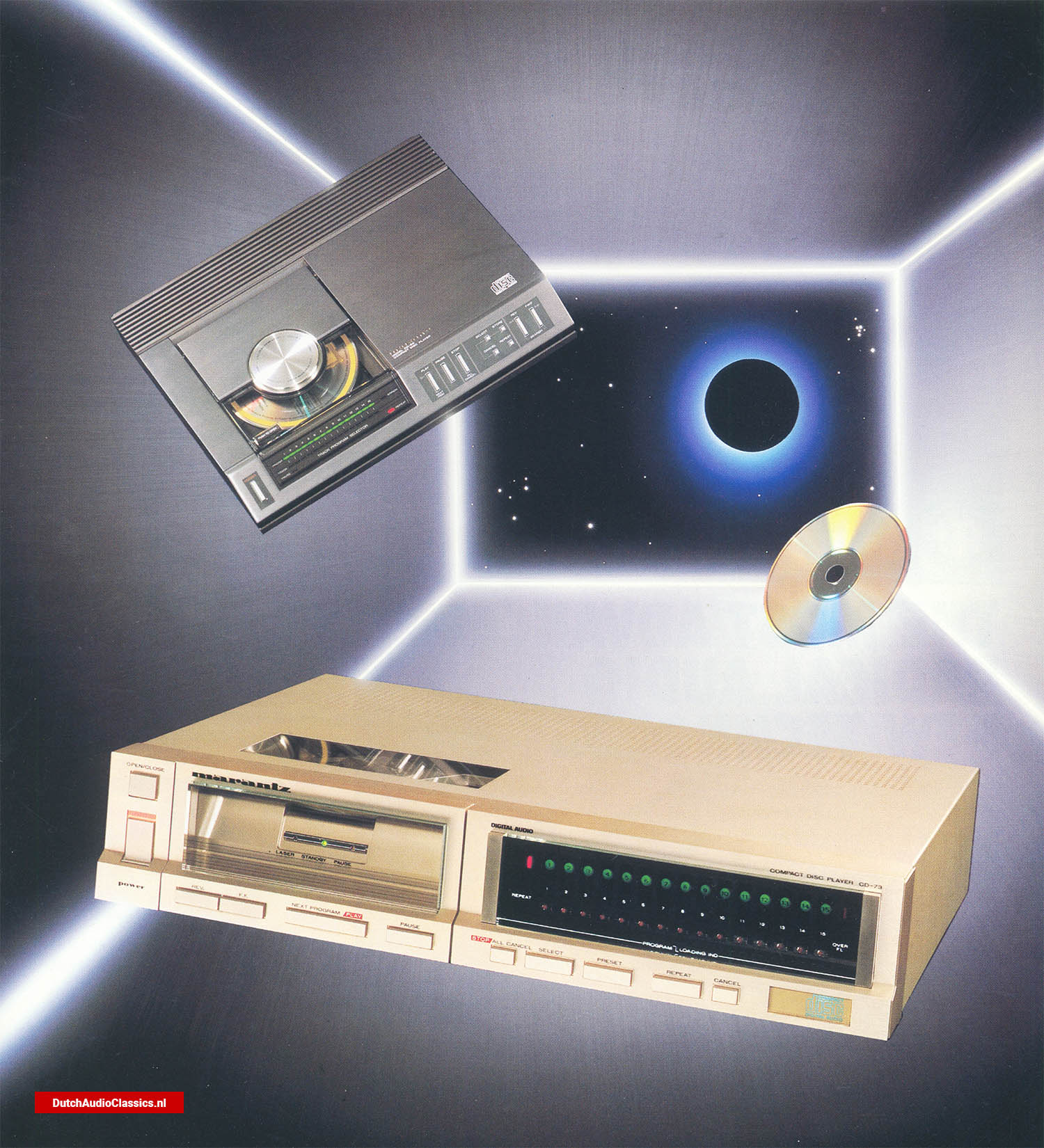
Much of the rear apron of the Marantz Marantz CD73 is occupied by a heat sink and a portion of the unit's power transformer that extends from the chassis. In addition to the gold-plated signal -output phono connectors (meant to feed a line -level amplifier input), there are two phono jacks marked rather cryptically IN (REMOTE) and EASY (OUT). These are intended for use with an optional remote -control accessory that the company plans to introduce later.
Laboratory Measurements.
Our test procedure for the Marantz Marantz CD73 was essentially the same as that used for the eleven CD players we tested for the July 1983 issue. The operating features and test results are summarized in the accompanying box using the format established in that issue, which we plan to follow in future reports on CD players. We were not always able to use the full capabilities of the standard Philips and Sony test discs, however, for these discs have from thirty-six to thirty-nine distinct tracks, and the Marantz CD73 has no easy means of selecting tracks numbered higher than fifteen. (It is possible, though very time consuming, to reach tracks numbered above fifteen by repeatedly pushing the NEXT PROGRAM/PLAY button.)
The Marantz CD73's (fixed) output level from a 0 -dB, 1,000 -Hz test tone measured 2.12 volts, with the channel levels matched within 0.12 dB. The frequency response, identcal for both channels, showed a slight cyclical variation above 2,000 Hz, but the overall level fluctuation of +0.1, -0.2 dB from 20 to 20,000 Hz was certainly negligible. The unweighted signal-to-noise ratio (S/N) relative to the player's maximum output at 1,000 Hz was 104 dB, and the A - weighted S/N was 114 dB. Both figures are outstanding.
The 1,000 -Hz harmonic distortion for recorded levels from 0 to -24 dB was measured using the Philips TS3 test disc (catalog number 410 055 2). We found it to consist of a number of harmonic components, all at very low levels (typically from -90 to -100 dB). All significant harmonics up to the ninth were included in our measurement. The distortion was in the range of 0.0044 to 0.0052 per cent at recorded levels from 0 to -6 dB, rising slightly to 0.0089 per cent at -12 dB and to 0.011 per cent at -24 dB. Distortion readings could not be made at lower recorded signal levels since the low-level distortion products were masked by system and test -instrument noise. It should be noted that the relatively "high" 0.011 per cent reading at a -24 -dB level corresponds to -103 dB referred to the 0 -dB level, or 0.0007 per cent as we usually measure distortion. So much for the alleged excessive low-level distortion from digital program sources.
The intermodulation distortion (using mixed signals of 60 and 7,000 Hz in a 4:1 ratio) was 0.007 per cent at 0 dB. The 1,000 -Hz channel separation was a very good 99 dB, and it was 96 dB at 20,000 Hz. The flutter was at most the residual of our test equipment, somewhat less than 0.002 per cent.
Conclusion.
The Marantz CD73 traverses a disc rather slowly; it took 11.5 seconds to slew from Track 1 to Track 15 of the Philips TS3 disc. But it had superior resistance to external shock and to disc defects. It took firm blows on the player's top or side to jar the laser pickup from its correct position relative to the disc, earning it an "A" rating in this respect. The Marantz CD73 also had no difficulty playing every part of the Philips TS4A test disc, whose progressively greater built-in surface defects eventually cause dropouts or even worse audible effects with most other CD players.
